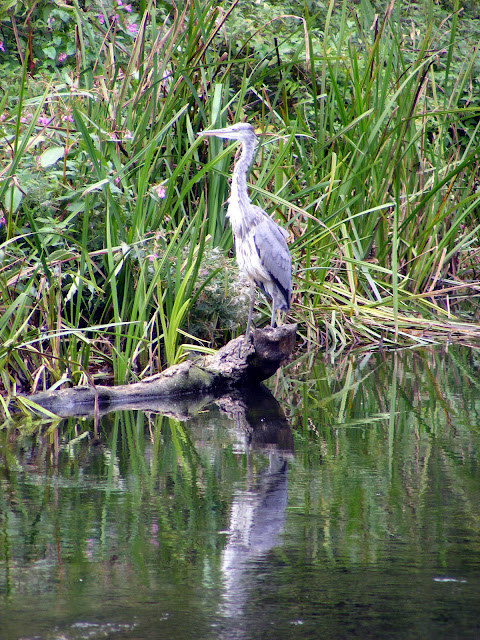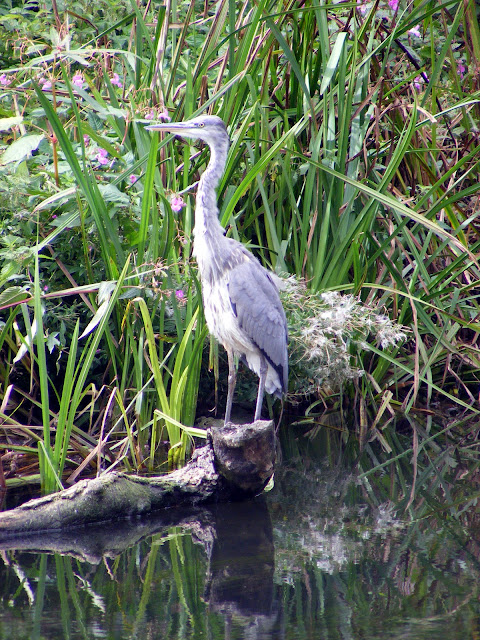.JPG) |
| Platform 4 Waterloo Station,London |
.JPG) | |
| All Saints Church |
.JPG) |
| Kingston Bridge |
.JPG) |
| Kingston Bridge over The Thames. |
I now cross Kingston Bridge to join the LOOP.
As you cross the bridge you enter Hampton Wick in Richmond Upon Thames.
The founding and naming of Richmond followed the Tudor building of Richmond Palace early in the 16th century. During this era the town was particularly associated with Elizabeth I.
Just across the bridge on a roundabout is the pretty White Hart Hotel.
Then crossing the road around the corner I enter Church Grove and opposite a Victorian Church I enter through a narrow Iron gate that leads onto a Horse Chestnut lined avenue,one of the entries to Bushy Park.
I now go through a big iron deer gate and head across a wide grassy path on Rough acid grassland still grazed by deer.
Bushy was one of the three parks enclosed by Cardinal Wolsey as part of his Hampton Court Estate and given to King Henry VIII along with the Palace.
I now come across Heron Pond and its various bird life.
.JPG) |
| Egyptian Geese |
I now take a divertion off the loop to see the Diana Fountain. The Diana Fountain is a seventeenth-century statue ensemble and water feature in an eighteenth-century setting with a surrounding pool and mile long tree lined vistas. Originally created for Somerset House in the 1630s, and remodelled about 1690, the fountain has stood since 1713 in Bushy Park, and now forms a large traffic island in Chestnut Avenue.
During the English Commonwealth ,Oliver Cromwell had the fountain relocated to the privy garden at Hampton Court Palace.
I now walk back down along Chestnut avenue to get back onto the LOOP.This was originally planned to provide a grand approach to King Williams III new north wing of Hampton Court Palace.But the wing was never built.
.JPG) |
| Chestnut Avenue |
I now enter the beautiful Woodland Gardens in Bushy Park. I would love to have stayed in Bushy Park all day its beautiful.Maybe a separate day visit to the park and Hampton Court Palace is needed.
.JPG) |
| First Signs of Autumn |
.JPG) | |
| Gunnera and reflections |
I
now exit the gardens onto Cobblers walk,here a tale of the struggle to
save access to our green spaces. Timothy Bennet a shoemaker from Hampton
Wick ,who established a right of way across the park.
I now get my first sight of Bushy Park's 300 strong herd of red deer.
Now a little further along I pass the Canal Plantation with The National Physical Laboratory behind.The National Physical Laboratory (NPL) is the national measurement standards laboratory for the United Kingdom, based at Bushy Park in Teddington, London, England. It is the largest applied physics organisation in the UK.
As
I now pass another pond I see yet more Red Deer that seem content with
playing in the mud and ripping the water lilies out with their antlers.
and now under a bridge to follow the River Crane.............
 |
| A Grey Heron On The River Crane |
I continue through Crane Park....................
Now I notice high earth banks around me and I come across a Brick tower known as the Shot Tower.
Here from the 16th century on were gunpowder mills that used the waters of The Crane to drive their mill-wheels. The powder was ground in small wooden sheds enclosed by those banks to retain the force of the all too frequent explosions.
In its original role,the tower would have been used to drop globules of molten lead into a vat of water,a crude way of forming lead shot. Now its a visitor centre for the London Wetland Trust.
I emerge out onto the A314 Hanworth Road,passing some shops and a pub. I cross the road after some road walking, pass a rough looking council estate and enter Hounslow Heath.Immediate signs of close proximately to the estate, the sty as you enter is littered with empty cans of lager,bottles and all kinds of rubbish!
I follow the Crane through the Heath and pass three men on bikes drinking cans of Stella,got some looks from these and made me feel uneasy,so I hurried along and out of the Heath.
I exit the heath by the Crown & sceptre pub on the A315 Staines Road. I cross the road and continue into Donkey Wood.
I cross over a footbridge crossing a millrace...................here were more gunpowder works and from the drop of the weir ,you can judge the power of the water that drove the mill.This is the Duke of Northumberland's River,cut about 1520 to serve the mills.Whilst the water powered the mills,the Alder and Willow growing along the banks were used to provide charcoal,an essential ingredient of gunpowder.
and along the path and eventually come to more high earthworks,more evidence of the gunpowder works.
Then there is a wooden walkway alongside the river..................
and then under a bridge showing more signs of being in London still in the forms of graffitti.
and then out to walk the busy road back to Hatton Cross Train Station,a nice walk about 10 miles in all.
.JPG)
.JPG)
.JPG)
.JPG)
.JPG)
.JPG)
.JPG)
.JPG)
.JPG)
.JPG)
.JPG)
.JPG)
.JPG)

.JPG)
.JPG)
.JPG)
.JPG)
.JPG)
.JPG)
.JPG)
.JPG)
.JPG)
.JPG)
.JPG)
.JPG)
.JPG)


.JPG)
.JPG)
.JPG)
.JPG)
.JPG)
.JPG)
.JPG)
.JPG)
.JPG)
.JPG)
.JPG)
.JPG)
.JPG)
.JPG)
.JPG)
.JPG)
.JPG)
.JPG)
.JPG)
.JPG)
.JPG)
No comments:
Post a Comment